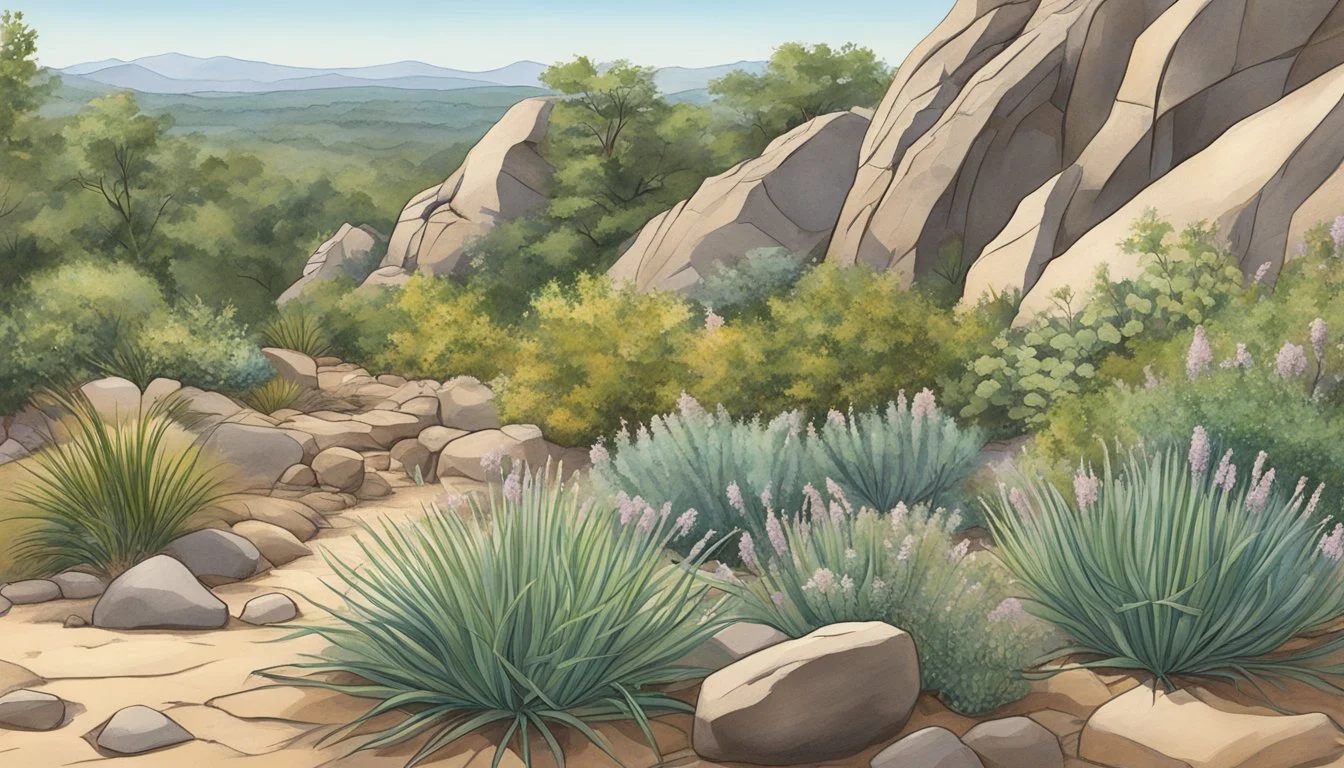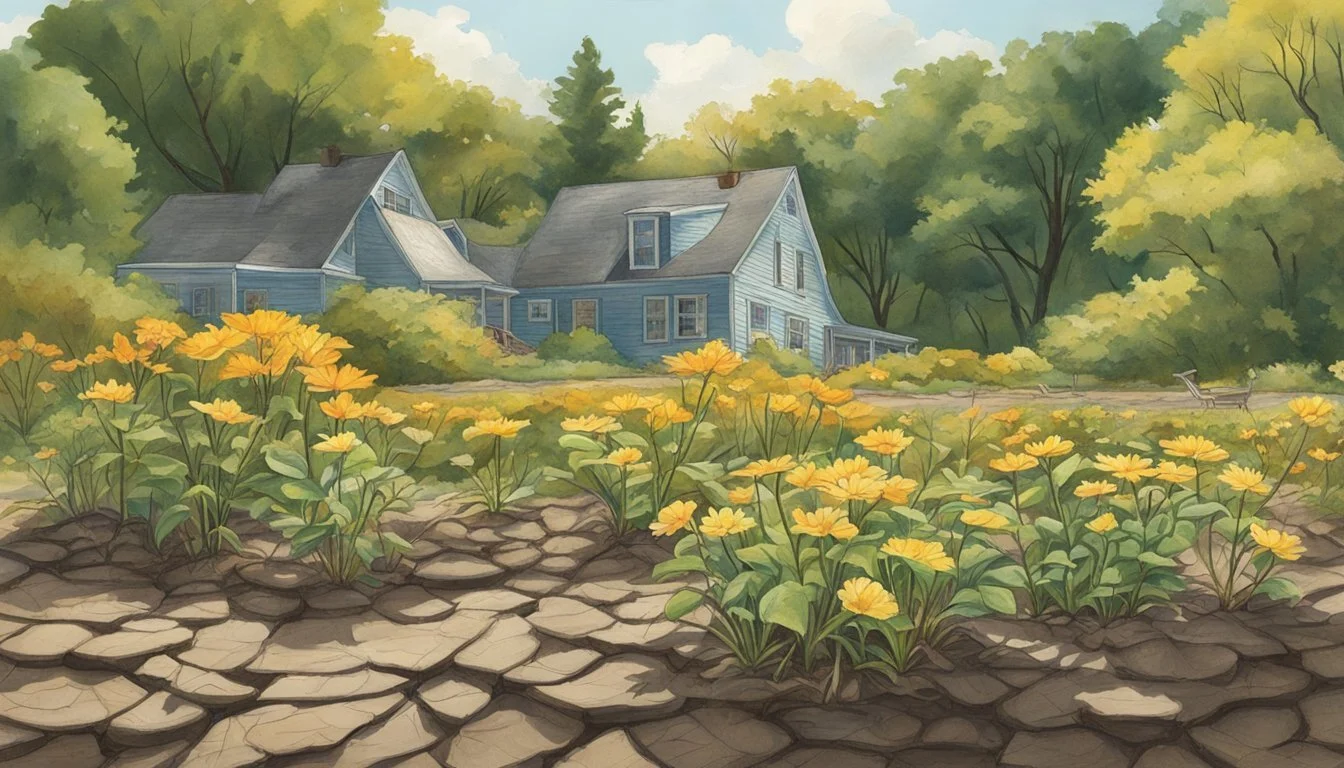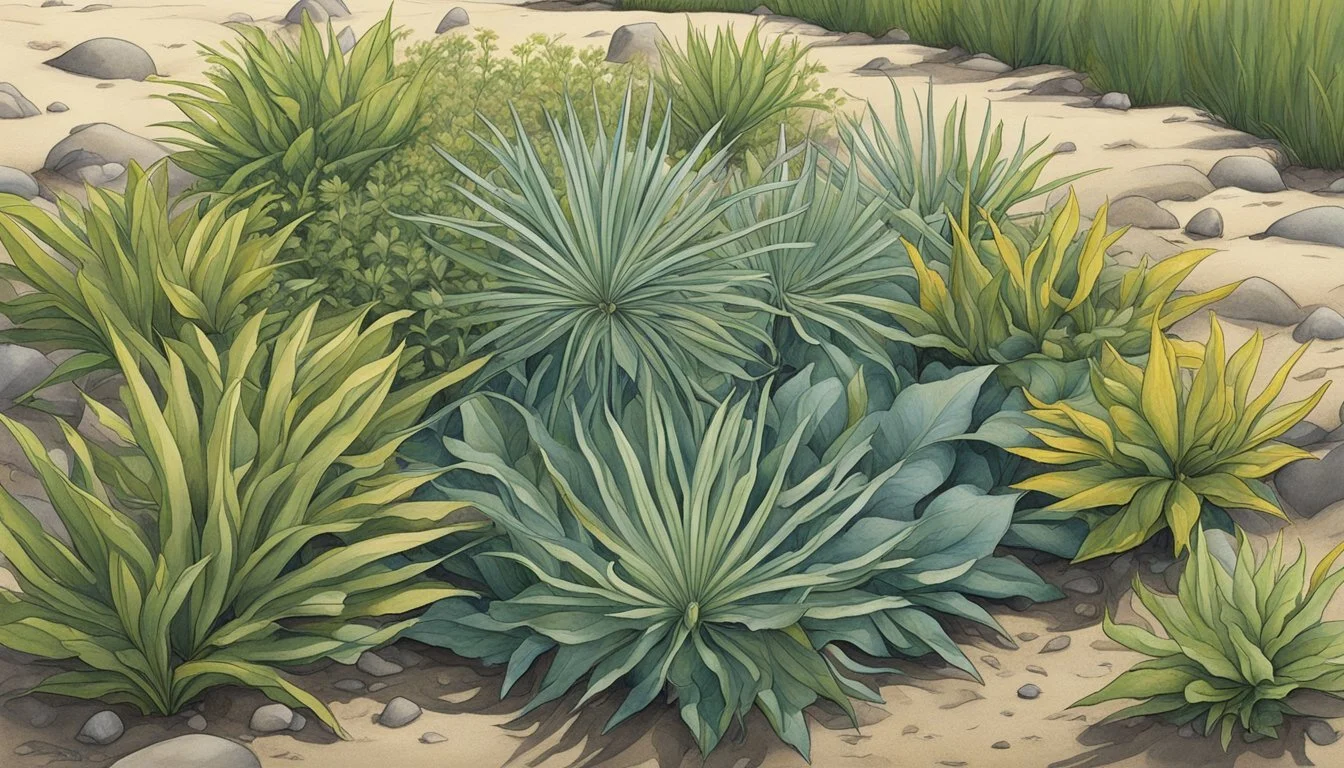Drought-Tolerant Plants in Massachusetts
A Guide to Resilient Gardening
In recent years, Massachusetts has experienced varying levels of drought, making the selection of appropriate plant species for landscaping more critical than ever. Drought-tolerant plants offer a sustainable solution, capable of thriving in the region's occasionally arid conditions. Selecting plants that naturally require less water not only conserves a vital resource but also ensures that gardens remain vibrant and healthy during periods of low precipitation. This adaptation is crucial for maintaining both private and public green spaces in Massachusetts.
Among the diverse flora suitable for Massachusetts' unique climate, drought-tolerant plants come in many forms, including deciduous trees, shrubs, evergreens, and perennials. Their ability to withstand dry spells does not detract from their aesthetic appeal. In fact, drought-tolerant plants can provide a variety of textures, colors, and shapes to any landscape. These species have evolved to survive in environments where water is a luxury, making them ideal for a low-maintenance and environmentally conscious garden.
Gardeners in Massachusetts have a broad palette of drought-tolerant plants to choose from. Options range from robust shrubs and flowering perennials to ornamental grasses and groundcovers, each bringing a unique character to a garden. When planning a garden with these resilient plants, it's important to consider their period of establishment. Initial care is vital for these plants to develop deep root systems that will enable them to cope with drought conditions in the long term. After establishment, they become a practical choice for an eco-friendly and water-wise landscape in the New England climate.
The Importance of Drought-Tolerant Planting in Massachusetts
Massachusetts experiences varying precipitation levels, with some years being particularly dry. Drought-tolerant planting is crucial in these periods of water scarcity. Plants that can thrive with minimal water reduce reliance on irrigation, conserving a precious resource and ensuring sustainability in the landscape.
Water Conservation: Choosing plants with drought tolerance helps to diminish water usage. This is particularly significant during seasonal dry spells or prolonged droughts, where water conservation becomes essential not just for garden maintenance but for the community at large.
A well-planned drought-tolerant landscape is less susceptible to the stresses of drought conditions. Such plants have adaptations like deep root systems or drought-resistant foliage, which allow them to withstand dry periods better than non-adapted species.
Maintenance and Cost: Landscapes with drought-resistant plants require less maintenance. They typically demand less frequent watering, thus reducing not only water bills but also the time and effort needed for upkeep.
Ecosystem Health: Incorporating native, drought-tolerant species can bolster local ecosystems. These plants provide habitat and food for native wildlife, supporting biodiversity.
In Massachusetts, residents are encouraged to consider these hardy plants for their gardens. Incorporating such flora is not just about individual benefit, but also about contributing to broader environmental resilience. Selecting appropriate species from the rich variety available for the Massachusetts climate can enrich the landscape aesthetically while fulfilling an important ecological role.
Understanding Drought Tolerance
Drought tolerance in plants is an essential survival trait in regions like Massachusetts, where variable rainfall can affect growth and sustainability. This section examines what it means for a species to possess drought tolerance and delves into the physiological adaptations that facilitate this trait.
Defining Drought Tolerance
Drought tolerance refers to the ability of plants to withstand low soil moisture conditions. Drought-tolerant species display a range of growth habits that enable them to survive periods of water scarcity. Understanding these characteristics is crucial for gardeners and conservationists aiming to maintain biodiversity and resilient landscapes, especially in the face of changing climate patterns.
Physiological Adaptations of Drought-Tolerant Plants
Drought-tolerant plants have evolved specific physiological adaptations to thrive in environments with limited water. These adaptations include but are not limited to:
Deep root systems: By extending roots deeper into the soil profile, plants access moisture that is unavailable to those with shallower roots.
Reduced leaf area: Smaller leaves and reduced leaf area diminish water loss through transpiration.
Stomatal control: The ability to close stomata during the hottest parts of the day helps in retaining moisture.
Waxy leaf coatings: A thick, waxy coating on leaves can reduce water loss by evaporation.
These strategies enable plants to optimize water usage and preserve vital functions during drought periods. The success of these adaptations is influenced by several factors such as species, growth habit, and soil conditions.
Selecting the Right Drought-Tolerant Plants for Your Garden
Choosing the appropriate drought-tolerant plants involves understanding their specific needs for sunlight exposure and shade, soil characteristics, and the ability to thrive in Massachusetts's climate. This selection process ensures a healthy, sustainable garden.
Considerations for Sun and Shade
When selecting drought-tolerant plants, it's imperative to consider the light conditions in your garden. Plants that are classified for full sun require at least six hours of direct sunlight daily and are ideal for open areas with minimal shade. If your garden offers partial shade, opting for species that can prosper with less intense sun exposure—typically between three to six hours—will be necessary.
Soil Requirements for Drought-Tolerant Plants
The success of drought-tolerant plants is also highly dependent on the soil pH and composition. These plants often prefer well-draining soil, and Massachusetts' gardens might need amendments to achieve this. Soil pH should typically be neutral to slightly alkaline; however, some plants may tolerate a wider range. Consider performing a soil test to determine your garden's conditions and adjust accordingly.
Evaluating Plant Hardiness and Climate Adaptability
Plant hardiness and feasibility in Massachusetts must be evaluated, as not all drought-tolerant plants are suited for the regional climate. The state falls within USDA Hardiness Zones 5 through 7, so it's crucial to select plants such as sedum or Russian sage that are adaptable to these zones. Gardeners should opt for drought-tolerant flowers and plants that can withstand the cold winters and variable New England weather patterns.
Popular Drought-Tolerant Plants in Massachusetts
Massachusetts gardeners looking for drought-tolerant plants can choose from a range of native perennials, shrubs, and trees that thrive in dry conditions while providing aesthetic appeal and supporting local wildlife.
Native Perennials and Grasses
Little bluestem (Schizachyrium scoparium) stands out as a native grass adapted to the dry New England climate, offering striking fall foliage and serving as habitat for wildlife. Sedum species, with their succulent foliage, are excellent for dry, sunny areas and provide a variety of texture and color.
Shrubs and Evergreens with Drought Resistance
For shrubbery with drought resistance, Myrica pensylvanica, commonly known as Bayberry, showcases fragrant foliage and offers edible berries. The holly species Ilex opaca is an evergreen choice well-suited to Massachusetts landscapes, tolerant of dry soil once established, and provides vibrant berries enjoyed by birds.
Drought-Adapted Trees for Massachusetts Landscapes
Among drought-adapted trees, the deciduous Sweet gum (Liquidambar styraciflua) delivers stunning fall color and is native to the eastern United States, thriving in Massachusetts's variable conditions. The versatile Hornbeam (Carpinus caroliniana) is another deciduous tree well-suited for dry areas and provides year-round interest with its distinctive bark and shape.
Flowering Plants and Groundcover Selections
In the realm of flowering plants and groundcovers, Lavender is both fragrant and exceptionally drought-tolerant, adding texture and color to gardens. Yucca plants offer a bold architectural element and are remarkably adaptable to dry conditions, often seen in New England landscapes for their striking form and foliage.
Caring for Drought-Tolerant Plants
Proper care enhances the resiliency of drought-tolerant plants, ensuring a sustainable landscape even with minimal water use. This section outlines specific practices in watering, soil management, and pruning that cater to the unique needs of these resilient species in Massachusetts.
Watering Practices for Drought-Tolerant Landscapes
Supplemental watering becomes crucial for drought-tolerant plants, especially during their establishment period. It's important to monitor soil moisture and water deeply but infrequently, promoting deep root growth. An effective guideline is to provide water to a depth of 6 to 12 inches beneath the soil surface, which encourages roots to spread downward, enhancing drought resistance.
Mulching and Soil Management
A layer of mulch aids in retaining soil moisture and regulating temperature. Organic mulches like shredded bark or straw should be applied to a thickness of 2 to 4 inches. They not only conserve moisture but also gradually improve soil structure as they decompose. Drought-tolerant plants typically thrive in well-drained soil, so amending the soil with organic matter can improve drainage and nutrient availability.
Pruning and Maintenance Tips
Pruning is essential to maintain the desired shape and promote healthy growth habits. Seasonal pruning minimizes the stress on drought-tolerant plants by removing dead or diseased wood and encouraging air circulation. It is best to prune during dormancy and follow specific pruning recommendations associated with the plant's growth habit to ensure their robust performance in challenging conditions.
Benefits of Drought-Tolerant Plants
Incorporating drought-tolerant plants into Massachusetts landscapes provides significant environmental and economic benefits, supports local ecosystems, and enhances visual appeal.
Economic and Environmental Advantages
Drought-tolerant species offer economic benefits by reducing the need for water. This conservation leads to lower utility bills and diminishes the strain on municipal water supplies, especially during periods of low rainfall. Environmentally, these plants often require less maintenance and fewer resources, such as fertilizers and pesticides, which can run off and contribute to pollution. Furthermore, they play a crucial role in erosion control, stabilizing the soil and mitigating the impact of heavy rains on the landscape.
Supporting Local Wildlife and Habitat
The introduction of native and drought-tolerant plants in a garden can provide essential habitat for local wildlife, including pollinators like bees, butterflies, and hummingbirds. These plants offer food sources and nesting areas that are vital for sustaining diverse species. By fostering a healthy ecosystem, they not only benefit wildlife but also enhance the resilience of the local environment against the stresses of climate change and drought tolerance.
Aesthetic Value and Year-Round Interest
Drought-tolerant gardens can be vibrant and dynamic throughout the year. These landscapes often include a mix of fragrant flowering plants, ornamental grasses, and evergreen shrubs, providing visual interest in all seasons. The inclusion of such species creates a visually appealing landscape that is not only attractive but also versatile, able to withstand harsh conditions without sacrificing beauty.
Frequently Asked Questions
In Massachusetts, selecting the right plants for gardens and landscapes involves understanding which species can withstand dry conditions. This section provides insight into native perennials, shrubs, and trees that excel in drought tolerance.
What are the best native perennials for drought conditions in Massachusetts?
Native perennials such as Purple Coneflower and Sedum are excellent choices for drought conditions in Massachusetts due to their low water requirements and hardiness.
Which native shrubs are known for their drought tolerance in Massachusetts?
Shrubs like Bayberry and the resilient Ninebark are recognized for their ability to thrive under the arid conditions frequently encountered in Massachusetts.
Can you list drought-resistant native trees that thrive in Massachusetts?
The Sweet Gum tree is notable for its drought resistance and is a native tree that thrives in Massachusetts, providing vibrant fall foliage.
What low-maintenance plants perform well under drought conditions in full sun in Massachusetts?
Low-maintenance plants such as Daylily and Yucca are well-suited for full sun exposure in Massachusetts and require minimal watering, even in drought conditions.
Which native plants in Massachusetts are known for exceptional drought and heat tolerance?
Plants like Amsonia and Lavender are recognized for their exceptional drought and heat tolerance, making them ideal for Massachusetts gardens.
How do native plants adapt to survive in regions with low rainfall?
Native plants have developed various adaptations such as deep root systems and water-conserving leaves to survive in areas with low rainfall, enabling them to thrive in Massachusetts' variable climate.








